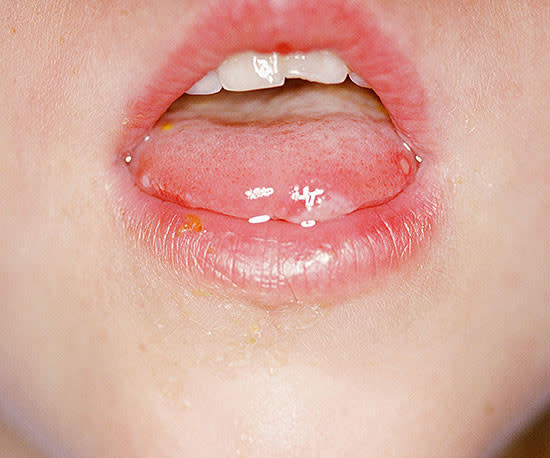What Is Hand, Foot, and Mouth Disease?

Hand, foot, and mouth disease (HFMD) is a childhood illness that usually isn't serious, but could wreak havoc on your household for about a week. The virus—usually coxsackie—sets up shop in your kid's gut and incubates for three to five days. First-day HFMD symptoms can include a fever, sore throat, and a lack of energy and appetite. Then the disease lives up to its name by distributing sores in the mouth and a rash on your child's hands and feet.
HFMD is most common in children under 5 and is primarily spread through oral fecal contamination—which might sound like your child ate her own poop. And if she's still in diapers, that could be the case: Babies' hands can sneak into dirty diapers pretty fast and then back into the mouth. Yuck. But actual transmission is usually a little more subtle. A child (or parent) who forgets to wash up after a bathroom trip can easily put an unwashed hand into his mouth. Children can also pass the virus around while playing together, explains Stephen Pishko, M.D., assistant professor of the general pediatrics division at the University of Tennessee Health Sciences Center and LeBonheur Children's Hospital in Memphis. The virus can survive for a long period of time on surfaces, meaning that daycares and schools are a major source of outbreaks.
One way or another, the virus has now made it into the mouth, where it will reside briefly before traveling to the gut. So, for a short period of time, someone who gets too close to a cough or sneeze could also end up with HFMD.
HFMD Symptoms
Loyola Medicine pediatric infectious disease specialist Nadia Qureshi, MD, says many parents confuse the rash with chickenpox. But chickenpox rashes usually start on the trunk of the body and move outward, while HFMD rashes center around the hands, feet, and mouth. The location of the sores and rash usually make diagnosis fairly easy, but what shows up when can vary from child to child. "The fever usually starts to go away before the blisters show up, but I've seen the fever coincide with the rashes, too," says Dr. Pishko. The mouth sores, called herpangina, typically appear two to three days later. "Sometimes you don't notice the oral lesions at first," says Dr. Pishko. Instead, parents spot the body rash, which develops about a day later. "And then they might realize their child wasn't eating or drinking well a couple of days before," adds Dr. Pishko.
Younger kids might not be too keen on a thorough throat examination, but if you can manage it, look for little blisters in the back of the throat, on the tongue, and inside the cheeks. The body rash, also in the form of little blisters, usually makes its debut on your child's palms and soles. "It can go to other places on the body, such as the arms and legs, but for the most part, it does affect the hands and feet," says Dr. Pishko.
HFMD Treatment and Prevention
The body rash usually does not itch, so the best HFMD treatment is just waiting it out. The mouth sores, on the other hand, can be quite painful and make eating and drinking difficult. Any kind of children's pain reducer, such as acetaminophen (Tylenol) or ibuprofen (Advil or Motrin), can help alleviate the discomfort of the mouth ulcers and fever, says Dr. Pishko. Avoid citrus and salt, which can just aggravate the sores.
Parents of kids with HFMD often call the doctor with concerns about dehydration. The mouth sores can sting and take the fun out of drinking and eating. Definitely keep an eye out for symptoms—which include a dry mouth, extreme thirst, decreased urine output or fewer wet diapers, and lethargy—but it's rare, says Dr. Pishko, for serious dehydration to occur as a result of HFMD.
How long is hand, foot, and mouth disease contagious? "Children may return to daycare or school when their fever has broken and the sores have healed," says Dr. Qureshi.
